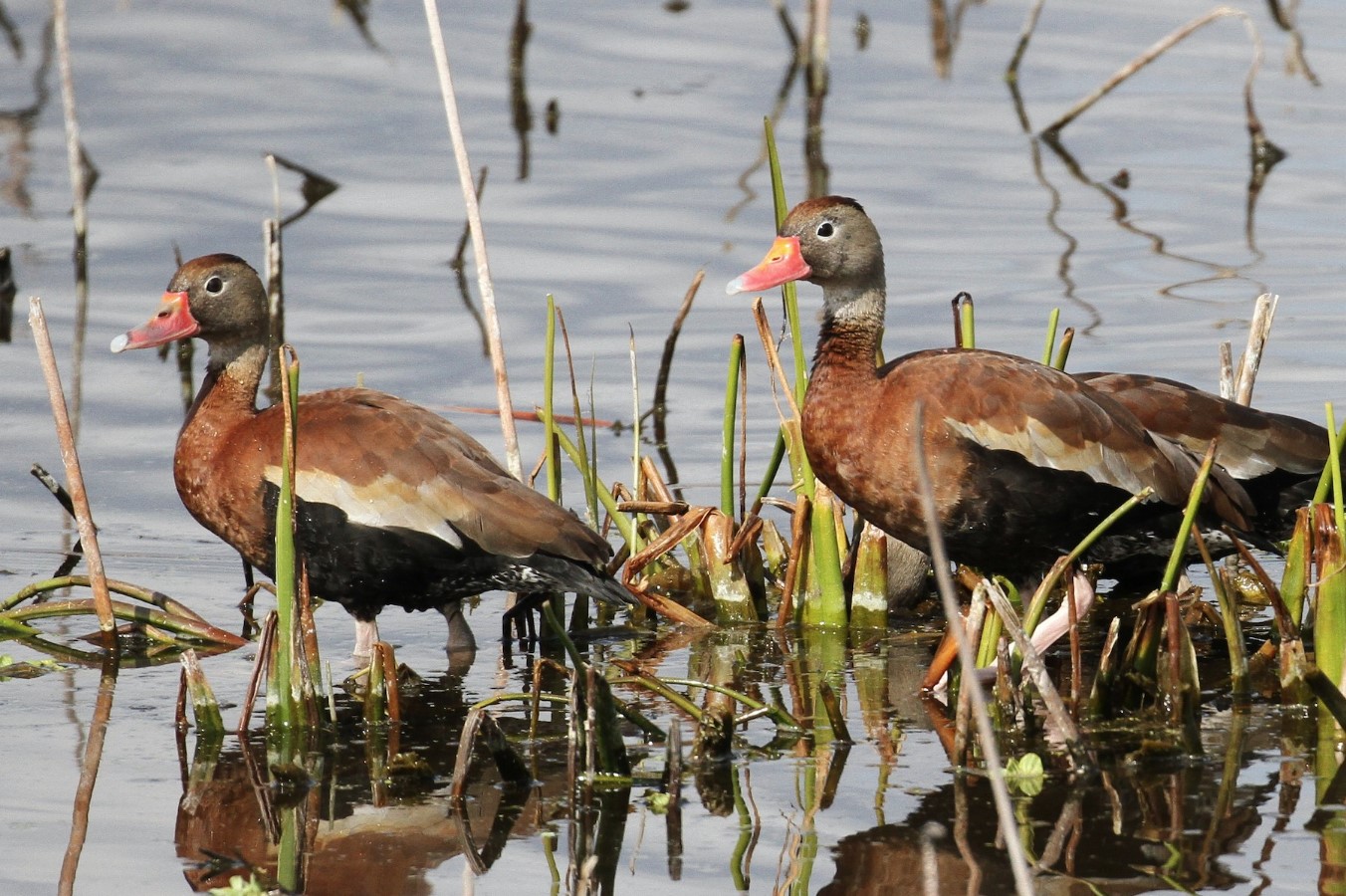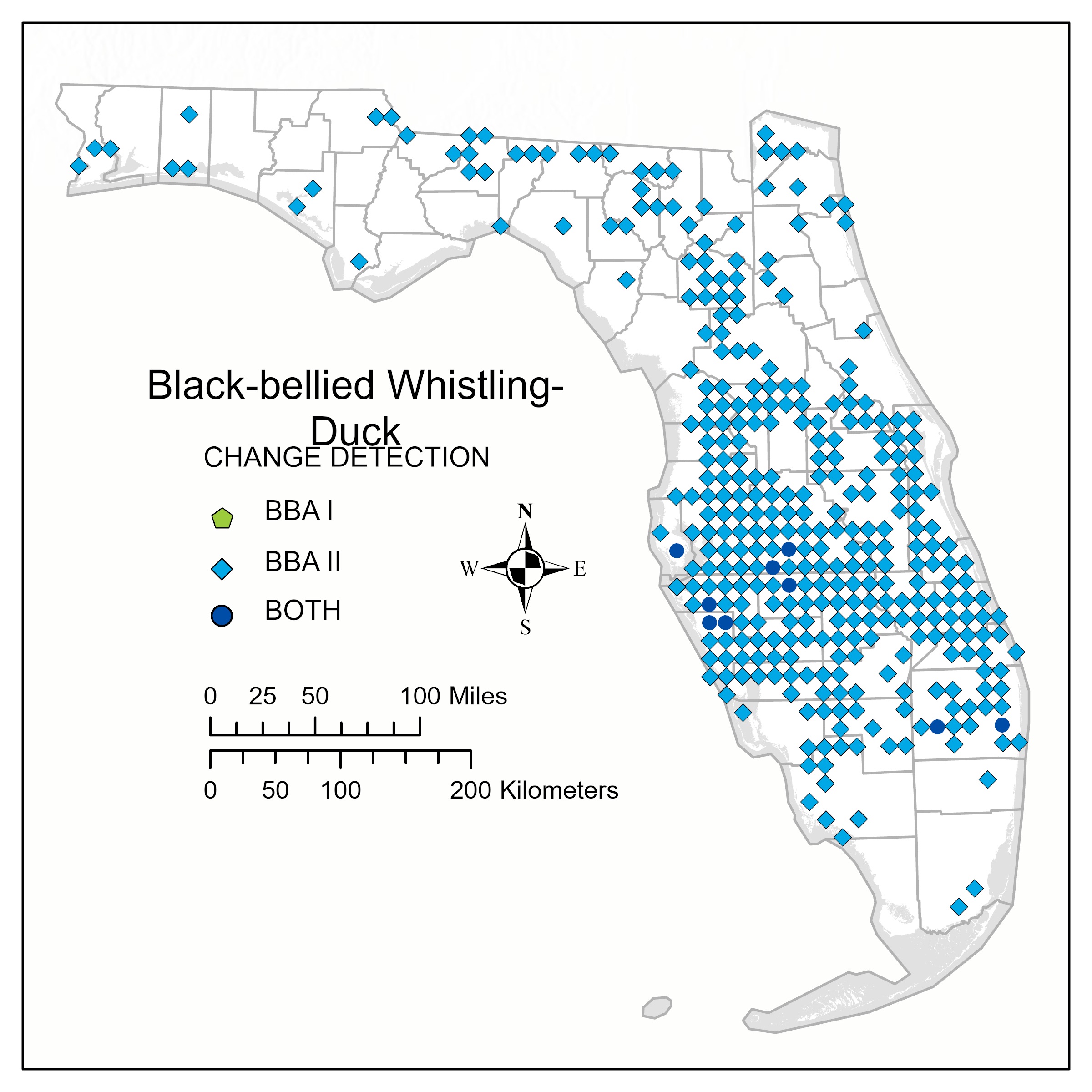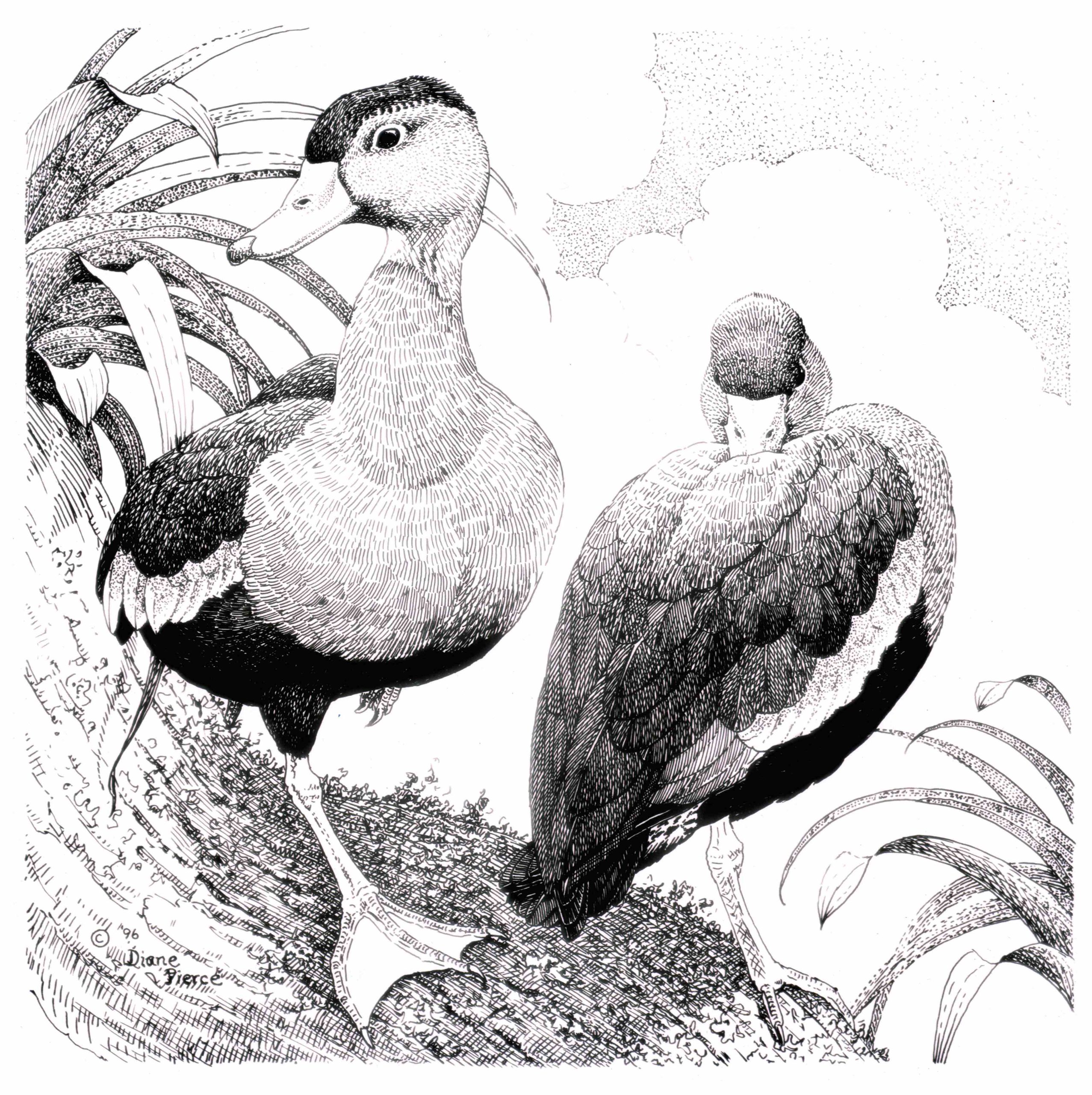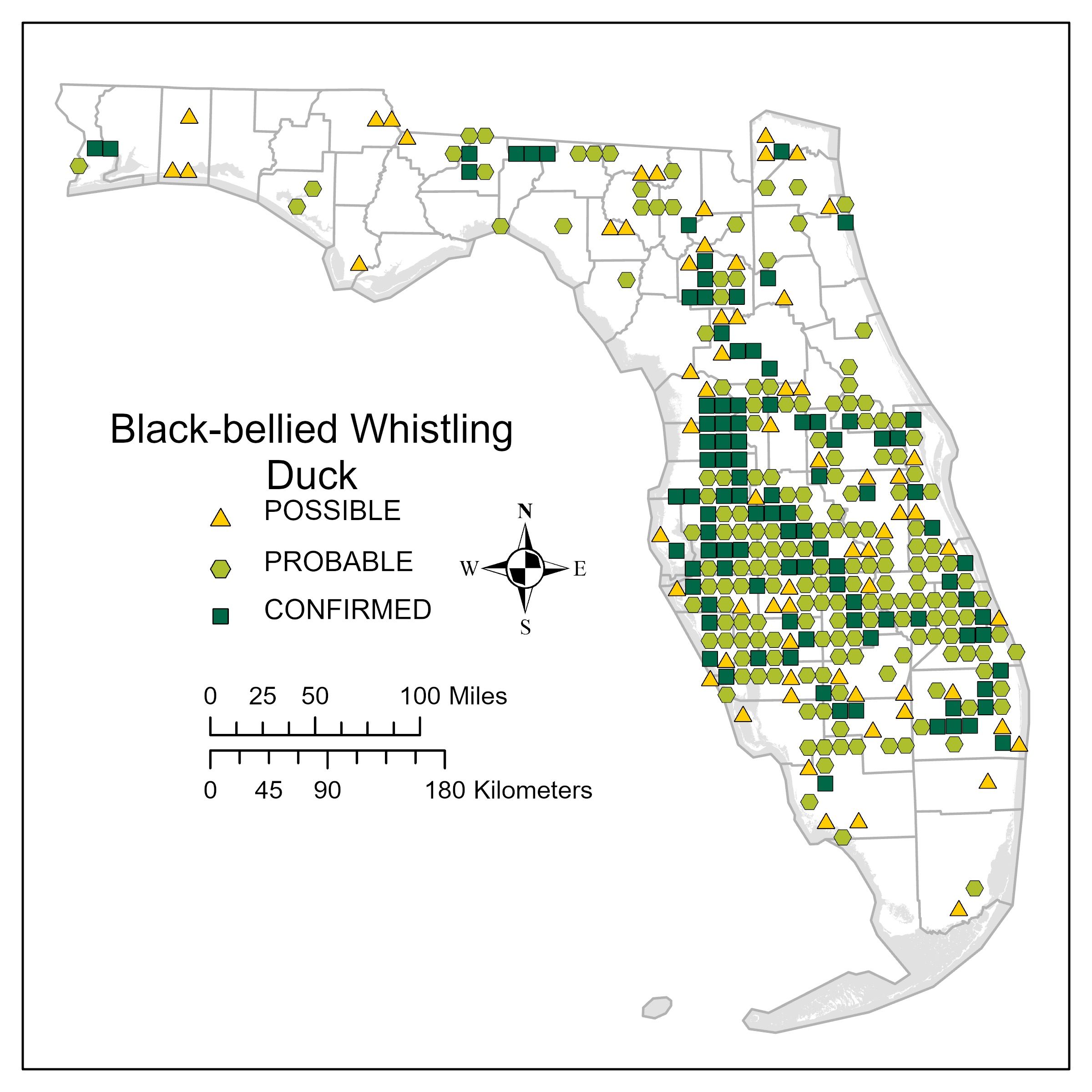Black-bellied Whistling-Duck
Dendrocygna autumnalisOrder: Anseriformes, Family: Anatidae
Species Account
The range expansion of Black-bellied Whistling-Ducks into and throughout Florida in recent decades has been astonishing. Their original range extended from southern Texas and Mexico south through Central America to southern Brazil, Paraguay, and northern Argentina (James and Thompson 2020). Beginning in the latter 1970s, Black-bellied Whistling-Ducks began a massive expansion northward and eastward in North America. By 2020, their range encompassed much of the eastern half of the lower 48 states and extreme southeastern Canada (eBird 2022) and continues to expand to the north and west. It is not known why the species has so greatly expanded its range and numbers when the ranges of most other wetland species are in decline.
From a single flock found at Sarasota in 1981, Black-bellied Whistling-Ducks now occupy virtually the entire Florida peninsula and an increasing area in the Panhandle. They remain largely unknown in the Keys, where freshwater habitats are scarce. The founding flock was thought to have originated in the Yucatan peninsula, Mexico and to have flown across the Gulf of Mexico (Pranty 2003). Eleven birds wintered in Sarasota in 1981–1982 and 5 or 6 of these remained through the summer. By the following winter, the flock had increased to 35 individuals and was now resident. Breeding was suggested in Sarasota County in May 1989 when a pair was observed copulating along the Myakka River, and was confirmed the following year in Hardee County, where a pair and brood of 12 mostly grown ducklings were photographed in September 1990 (Palmer 1991, Pranty 2003).
Citation: Pranty, B. 2023. Black-bellied Whistling-Duck (Dendrocygna autumnalis). Pages 64-68 in A. B. Hodgson, editor. Florida Breeding Bird Atlas II. Special Publication Number 9. Florida Ornithological Society, Tampa, USA.
Banner Photograph: Alexander Lamoreaux
Illustration: Diane Pierce
During the first Florida Breeding Bird Atlas, Black-bellied Whistling-Ducks were found in 10 quadrangles in the southern half of the peninsula (Pranty 2003). The massive range expansion is obvious from the BBA II map (Figure 1), with the central peninsula especially blanketed with records. The number of quadrangles occupied by whistling-ducks increased dramatically to 342 during BBA II (Table 1). All the quadrangles occupied by whistling-ducks during BBA I remained occupied, with great expansion into additional areas (Figure 2). Black-bellied Whistling-Ducks were first found in the Florida Keys in 2019 (eBird 2022), three years after BBA II concluded.
Black-belied Whistling-Ducks are conspicuous, gregarious, and noisy, allowing the species to be found readily during atlasing. Feeding mostly at night, they are most often seen during daylight hours loafing along wetland edges or flying overhead. Black-bellied Whistling-Ducks form permanent pair-bonds (James and Thompson 2020), allowing for a determination of probable breeding via the pair code to be readily obtained. The species is single-brooded and a late nester in Florida, with ducklings conspicuous in August and September; atlasing effort that ended in July would likely have missed confirmation of breeding. The concentration of confirmed breeding records in central Hernando and central Pasco counties is likely related to thorough atlasing coverage. Conversely, the lack of records to the east, in Sumter and Lake counties, is doubtless due to the difficulty accessing (despite the road and trail network) much of the Green Swamp Wilderness Preserve.
Black-belied Whistling-Ducks are conspicuous, gregarious, and noisy, allowing the species to be found readily during atlasing. Feeding mostly at night, they are most often seen during daylight hours loafing along wetland edges or flying overhead. Black-bellied Whistling-Ducks form permanent pair-bonds (James and Thompson 2020), allowing for a determination of probable breeding via the pair code to be readily obtained. The species is single-brooded and a late nester in Florida, with ducklings conspicuous in August and September; atlasing effort that ended in July would likely have missed confirmation of breeding. The concentration of confirmed breeding records in central Hernando and central Pasco counties is likely related to thorough atlasing coverage. Conversely, the lack of records to the east, in Sumter and Lake counties, is doubtless due to the difficulty accessing (despite the road and trail network) much of the Green Swamp Wilderness Preserve.

Data

Table 1

Maps
Figure 1
Figure 2

Figure 3

Figure 3. Mean number of Black-bellied Whistling-Ducks per Breeding Bird Survey route, 1966-2019. Survey-wide routes are in red, Florida routes are in blue. Dotted lines are 95% confidence intervals. Vertical gray bars show years of BBA I (1986-1991) and BBA II (2011-2016). Source: Sauer et al. 2020.
References
James, J. D., and J. E. Thompson. 2020. Black-bellied Whistling-Duck (Dendrocygna autumnalis), version 1.0. In A.F. Poole and F.B. Gill, editors. Birds of the World. Cornell Lab of Ornithology, Ithaca, New York, USA.
National Audubon Society (NAS). 2022. Christmas Bird Count data. www.christmasbirdcount.org. Accessed 9 September 2022.
Palmer, T. 1991. First nesting record of Black-bellied Whistling-Duck in central Florida. Florida Field Naturalist 19(3):79–81.
Pranty, B. 2003. Black-bellied Whistling-Duck (Dendrocygna autumnalis). In Florida Fish and Wildlife Conservation Commission (FWC), editor. Florida’s Breeding Bird Atlas: A collaborative study of Florida’s birdlife. Tallahassee, USA. myfwc.com/bba.


